Arthropoda-
Charateristics
- Moult exoskeleton
- to grow ecdysis
- is expensive in terms of energy consumption
- during the moulting period, an arthropod is vulnerable
- Greatest number of species 80%
- Segmented body structures with appendages
- Arthropods- means- jointed feet
- Exoskeleton allows for resistance to dehydration
- Hardened exoskeleton (chiton)
- Jointed appendages
- Fuse and modified segments (tagma-ta)
- Respiratory structures
- tracheal systems air sacs leading from pores called spiracles in the epidermis cuticle
- or gills for aquatic species
- Specialized sensory structures for locomiton and defence
- Divison of labor
- Example insects (bees)
- reproductive
- queen females
- workers
- drones males
- Open circulatory system- Haemolymph, a copper-based blood analogue, is propelled by a series of hearts into the body cavity where it comes in direct contact with the tissues.
- protostomes.
- coelom- is reduced to a tiny cavity around the reproductive and excretory organs
- dominant body cavity is a haemocoel, filled with haemolymph which bathes the organs directly
- Chiton Exoskelton
- inner zone (procuticle)- made of protein and chitin (a polysaccharide)
- responsible for the strength of the exoskeleton
- outer zone (epicuticle) lies on the surface of the procuticle
- made ofnonchitinous and is a complex of proteins and lipids.
- provides the moisture proofing and protection to the procuticle.
- The exoskeleton takes the form of plates called sclerites on the segments, plus rings on the appendages that divide them into segments separated by joints.
NOTE**** Our class combines Hexapods and Myriapods- into Unirmia so we studied 4 subphyla
Arthropods are typically classified into five subphyla:
1.Trilobita are a group of formerly numerous marine animals that died in the mass extinction at the end of the Permian.
2.Cheliceratainclude spiders, mites, scorpions and related organisms. They are characterised by the presence of chelicerae.
3.Myriapodacomprise millipedes and centipedes and their relatives and have many body segments, each bearing one or two pairs of legs. They are sometimes grouped with the hexapods.
4.Hexapoda(Uniramia) comprise insects and three small orders of insect-like animals with six thoracic legs. They are sometimes grouped with the myriapods, in a group called Uniramia.
5.Crustacea(Biramia) are primarily marine (a notable exception being woodlice) and are characterised by having biramous appendages. They include lobsters, crabs, barnacles, and many others.
Chelicerata
Originated in the sea
Are few still marine (horseshoe crab, sea spiders)
- Terrestrial
- 8-6 legs
- mostly carnivorous, feeding on the pre-digested bodies of insects and other small animals
- Others are parasites, some of which are carriers of disease
- usually lay eggs, which hatch into immature adults.

Spiders
Body Plan Spider
Body cavity- hemocoel- blood seal
Pigment in blood is hemocyanin
- Blue from Copper (Cu)
- Us: Red from Iron (Fe)
- All have poison gland
Compound eye- several pairs
3 types of silk –made of proteins
- Strongest natural know fibers
- Bacteria, are created with silk producing genes from spiders
- Dangerous spiders
- Brown recluse- fiddle back,
- brown not in Maryland have hemotoxen
- Kills cells that never heal
- Necrotic skin (it dies) and sometimes has to be removed
- Black widow spider- cannibalistic
- Neurotoxin- very painful if bitten


Black widow______________________________Brown Recluse
Merostoma
- Horseshoe crabs- Merostoma Limulus
- Tail for turing over
- Oldest arthropod still living
- Apendage Arrangment
- 1 chilicerae
- 2 pedipalps
- 3-6 Legs
- 7 Book gills
- 2 body regions
- Compound eyes and ocelli
- Resistant to Gram- bacterial
- Sharp seta- but not harmful
- Exoskeleton are ground up and used as protein supplements in animal food
- Used in Wood’s experiment to understand human vision
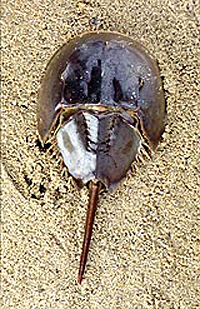

Scorpions
- Floresent – glow in black light
- Poison gland found at the end of the post-abdomen
- Centruroides sculpturatus – dangerous scorpion

Daddy longlegs
- Phalangida
- Opiliones
- Not spiders because they have only one not two body regions
- They are not poisonous
- No silk glands
Mites- stored food mites Tyrophagus Putrescentiae- problems arise in unsealed food

Chiggers – found in grass

Ticks

- lyme disese (from Lyme, CT)
- Parasites
- Have sensory pits on appendages to detect CO2
Crustaceans-
- most are marine
- some teresterial
- Three body parts
- head,
- thorax,
- abdomen (or pleon)
- * head and thorax may fuse to form a cephalothorax,
- three pairs of mouthparts
- telson.
- Smaller crustaceans respire through their body surface by diffusion
- larger crustaceans respire with gills.
- have a thick carapace on the dorsal side of their
- Reproduction
separate sexes
- distinguished by appendages on the abdomen called swimmerets or pleopods.
- The first (and sometimes the second) pair of pleopods are larger on the male than on the female.
head has two pairs of antennae and three pairs of food hangling appendages
Biramous appendages
Copepods

Crayfish
Barnacles
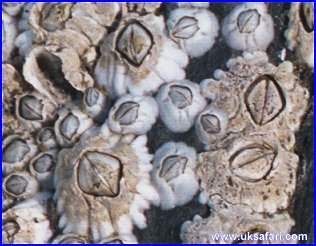

Lobsters
Shrimps
Isopods (pillbugs)
Crayfish dissection
Here's a helpful link that asks questions about structures and functions

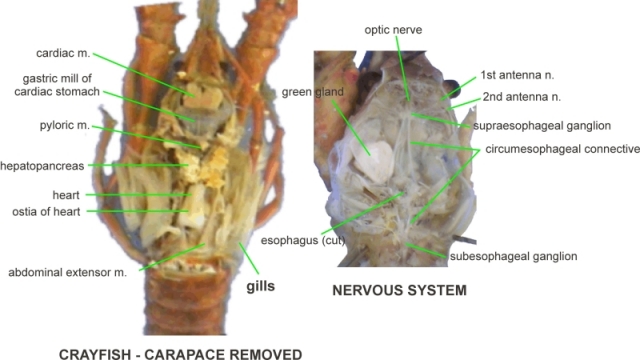

Myriapoda
Millipedes or millepedes (Class Diplopoda)
- very elongated arthropods
- cylindrical bodies
- have two pairs of legs for each one of their 20 to 100 or more body segments
- detritivores- eat decaying leaves and other dead plant matter, moisturizing the food with secretions and then
- scraping it in with the jaws.
- slow and nonvenomous
- burrowers
- defense-
- curl-up into a tight ball
- some have acidic substances that can burn insects
- if irrated or crushed – give off odor
scavengers
Centipedes –Class Chilopodaare
- fast-moving venomous, predatory
- terrestrial arthropods
- that have long bodies
- many jointed legs.
- nocturnal,
- tropical climates.
- highly segmented (15 to 173 segments), but with one pair of walking legs per segment.
- Centipedes are dorso-ventrally flattened, and are among the fastest and most agile of arthropod predators.
- head
- of a centipede has a pair of antennae
- jaw-like mandibles, and other mouthparts that evolved from modified appendages.
- anterior trunk segment has a pair of venomous claws (called maxillipeds)
- defense
- for capturing and paralyzing prey.
- venom can be dangerous to humans in some
- Predators, with venom glands on head
Insect body plan
- Thorax- usually has three pairs of legs and one or two pairs of wings
- Abdomen contains most internal organs and specialized structures for reproduction
- Three-part gut
- Malpighian tubules attach to mid-gut and serve in elimination of wastes
- The only winged invertebrates
- More than 80,000 species known
- Most successful species are small in size and have a great reproductive capacity
- Different stages instars exploit different resources at different times
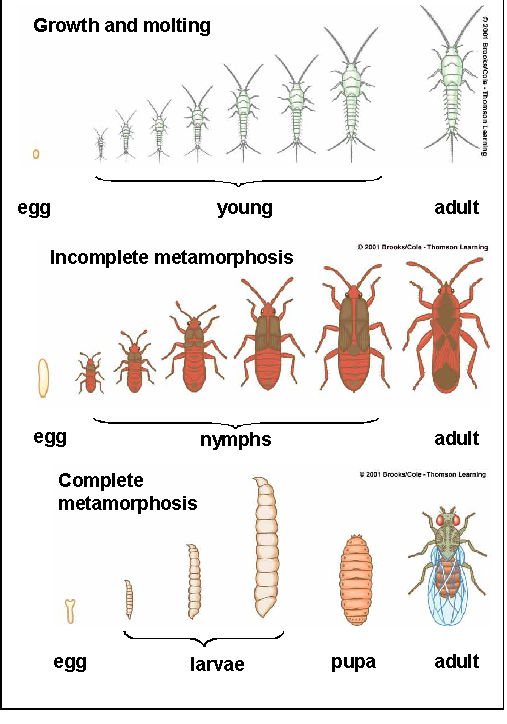
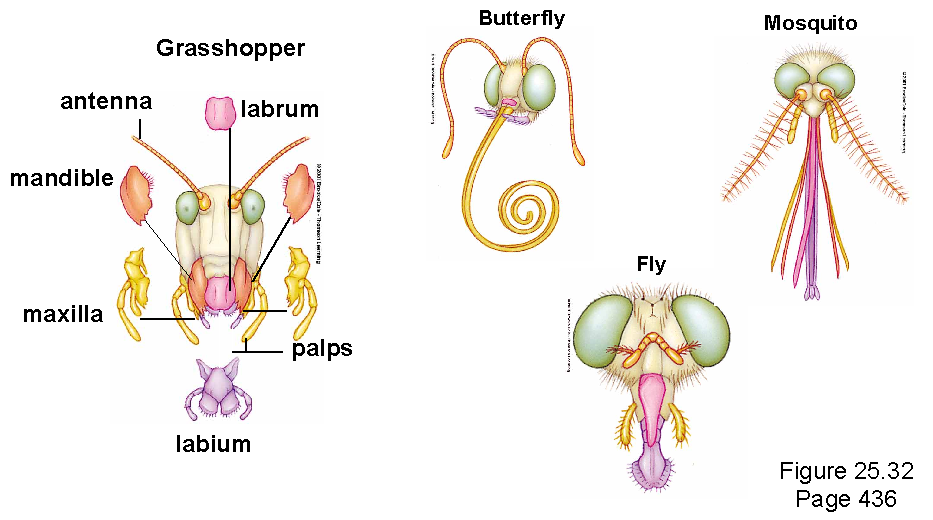
Home

















